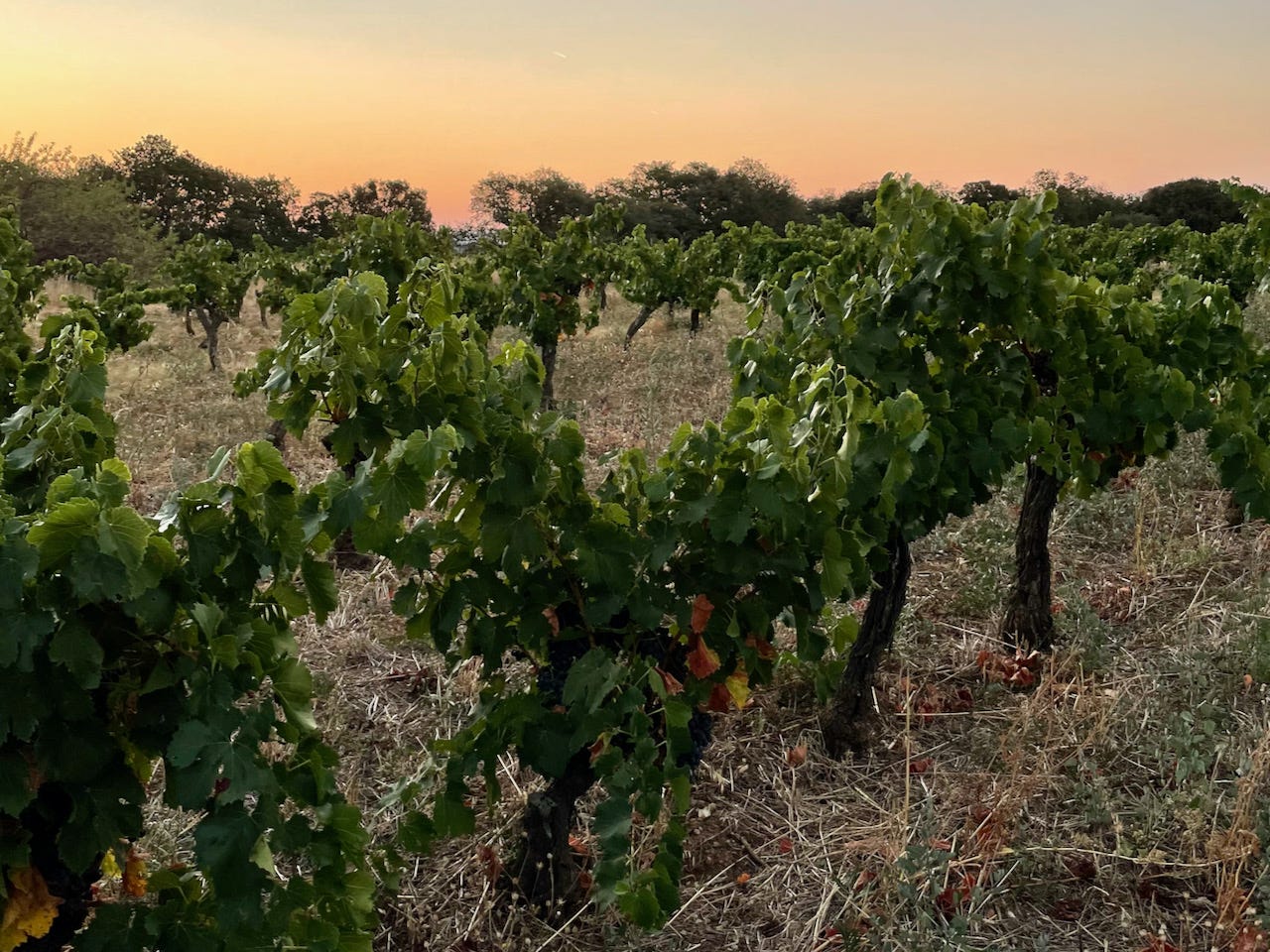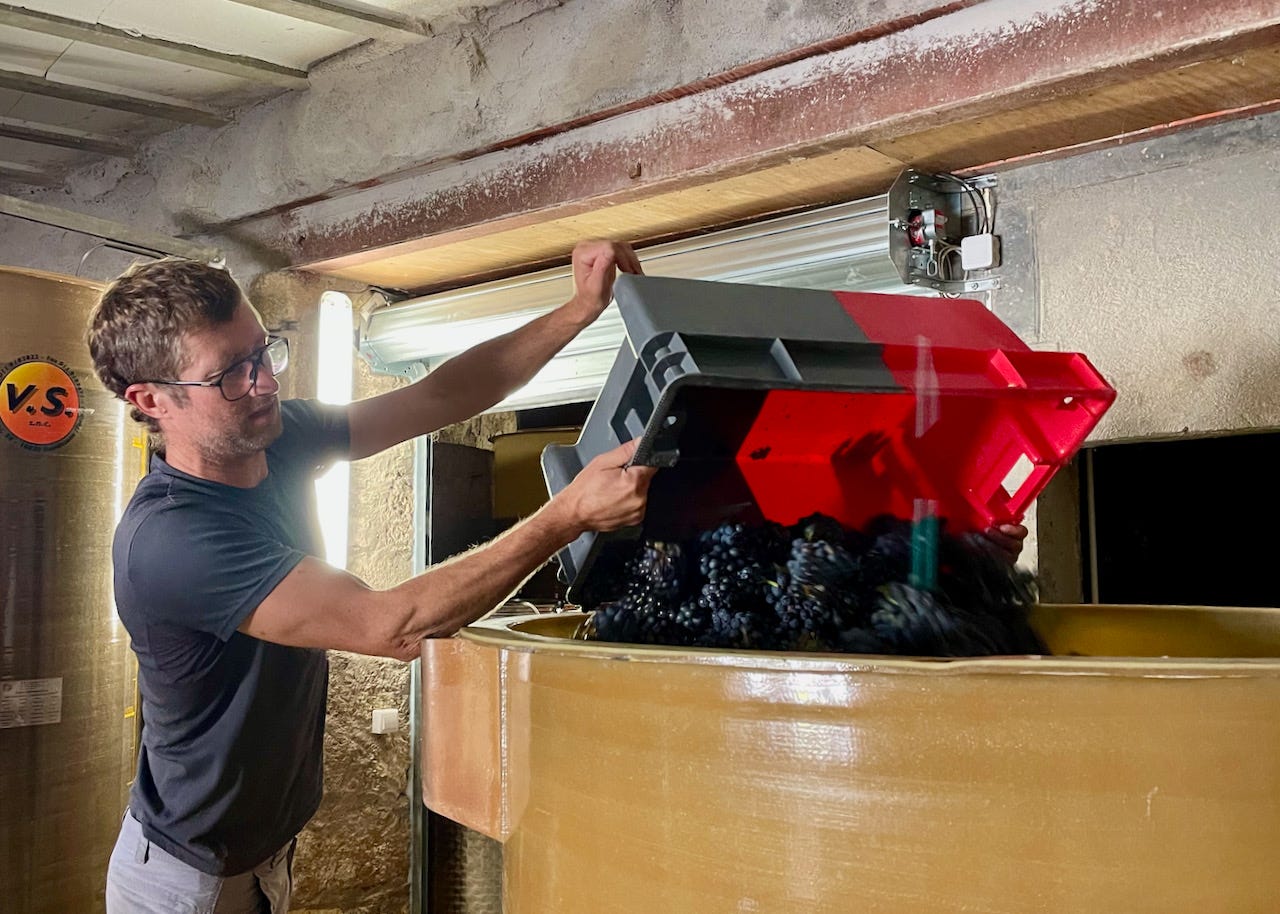A Grand Cru of the Hérault
One and a half million years in the making. A visit to the basalt-limestone scree vineyard that yields Joe Jefferies' magnificent "Pierre de Sisyphe" blanc.

Originally from Warwickshire, Joe Jefferies moved to the Languedoc in 2003. There he met his wife, Amandine, whose father hobby-farmed a small surface of grenache and grenache blanc on the ancient lava flow near Caux. By the end of a decade, Jefferies had become a vigneron, drawn to natural winemaking principles both by instinct and the encouragement of peers like Remi Poujol, Julien Peyras, and Antony Tortul. With neither the familial viticultural background of Poujol or Peyras, nor the long vinification experience of Antony Tortul, Jefferies has carved, in fits and starts, a unique profile in the region, offering long-fermented, tank-aged, terroir-driven whites and reds from a smattering of excellent volcanic terroirs.
His wine range remains in evolution. But one constant (or near-constant) has been his majestic “Pierre de Sisyphe” blanc, composed mostly from terret and terret gris situated on a fascinating parcel of basalt and limestone scree at the edge of the area’s ancient lava flow. In the years when it is produced, the wine evinces a complexity, a soul, and a salinity that distinguish it among the whites of southern France. I had the occasion to visit the parcel with Jefferies back in March, and returned again to join his final day of harvest in early September.
Quick Facts
Joe Jefferies farms 4ha near the village of Caux, comprising grenache, grenache blanc, grenache gris, carignan, terret, terret gris, cinsault, and ugni blanc. (He formerly had a small surface of young-vine marsanne, but sold it this year.)
Jefferies worked as a bike tour guide throughout the 2000s, before doing a winemaking degree in Montpellier in 2010, alongside classmates like Lolita Sène and Thomas Rouannet.
Jefferies first encountered his neighbor Bernard Bellahsen in the mid-2000s in the context of the bread Bellahsen makes for local distribution. Later Jefferies fell in with neighboring vigneron Remi Poujol, who was also moving in a natural direction at the time, and nearby vigneron Julien Peyras and négociant Anthony Tortul, who both already vinified without additives. Tortul and Poujol brought Jefferies into the early circle of vignerons producing BRUTAL!!! cuvées.
2013 was Jefferies’ first vintage on native yeasts. His wines have seen neither sulfite addition nor filtration since the 2015 vintage. He uses a Vaslin press. Macerations and aging are conducted in fiberglass tank.
In the last two years, he’s diverged from the long red macerations practiced by many of his immediate peers, preferring a shorter, 6-8 day maceration on reds.
AN INTROVERT ON INVERTED RELIEF
Beside Joe Jefferies’ 0.4ha parcel of grenache blanc on the lava flow above the village of Caux is a small dry stone cabin restored by his father-in-law, a former hobby winegrower. Around its base his father-in-law still enjoys collecting wild asparagus, radishes, and herbs for salads. The grenache was trained high to accommodate machine-harvesting; nowadays Jefferies tries to retrain them lower, to encourage a reversion to gobelet.
“This is my father-in-law’s vineyard, and I was a bit reticent to change it in the beginning. You know: Who’s this Englishman? Are you sure he knows what he’s doing?” he says. “Now he seems to be more or less okay with the idea.”
Tall, athletic, and bespectacled, Jefferies is a study in contrasts between sportiness and bookishness. Reflective to a fault, he speaks in sentences laden with qualifiers and self-effacing jokes. Following his short career hasn’t been easy, because extreme weather incidents, along with his own evolving tastes in winemaking, have meant that the identities of his cuvées have shifted greatly from year to year. He suffered great losses in yields from a drought in 2016, and a scorching heatwave coupled with drought in 2019. The latter vintage was particularly traumatizing: an untimely sulfur treatment caused his carignan leaves to burn away entirely. When I visited during in the aftermath, Jefferies and his wife Amandine seemed to be questioning the viability of raising two children on the income of a vigneron. Amandine subsequently took a job at the town hall.
To his credit, despite these setbacks, Jefferies hasn’t wavered in his commitment to organic viticulture and natural vinification. He’s practiced organics since he began producing wine in 2011. He ceased yeast addition in 2013, and ceased all sulfite addition in 2015.
“Faced with the realities of conventional organic winemaking, I realized it involved quite a lot of hocus-pocus,” he says. “And the physical act of adding poison to your wine is something I had a big problem with, on a visceral level.”
Jefferies’ radicalization as a winemaker occurred alongside friends and neighbors like Bernard Bellahsen, Julien Peyras, and Remi Poujol. Today Jefferies is one of the few dozen members of the Association des Vins Naturels. He’s also part of the clique of winemakers surrounding Anthony Tortul and the BRUTAL!!! phenomenon. He keeps a strikingly low profile, however, generally failing to maximize the media opportunities that accompany being an expat natural vigneron in France with a good sense of humor.
“I’m of a relatively stubborn character,” he admits. “I just look after my own end of things. So I’ve always considered myself to be a little bit out of the loop.”
I’d never seen his wines before encountering him at the Les Anonymes salon in Angers in early 2018. (Later I’d encounter them at Bar Brutal in Barcelona and Den Vandrette in Copenhagen.) Tasting the 2017 “Pierre de Sisyphe” white as a tank sample was a eureka-moment for me. It is a wine of such character and grace that one is able to infer the existence of a grand terroir behind it, even in the midst of a crowded tasting room in Angers. I visited Jefferies several times since then, and purchased his wines for various projects. But it wasn’t until March of this year that I finally had the occasion to visit the parcel itself.
The “Pierre de Sisyphe” parcel is composed of terret, terret gris, and carignan vines around seventy-years-old, situated just at the edge of the local ancient lava flow, on a gentle eastward slope. Towards the woods at its summit, where much of the terret is planted, it’s primarily basalt terrain, which becomes increasingly mixed with limestone scree as one descends. The site was on the border of what is called an inversion of relief, a phenomenon in which the arrival of a durable, erosion-resistant geological matter (volcanic basalt, in this case) creates the conditions for valleys to become ridges and for ridges to become valleys. One and a half million years ago, when the volcane des Baumes erupted, the lava flowed into what was then a valley. With the passage of time, the limestone hills surrounding the valley eroded away, leaving the ancient lava flow as a ridge.
“When everything eroded, the edges of the basalt plateau sort of disintegrated into the soil here, and left loads of chunks,” Jefferies explains.
Recently Jefferies planted more massal-selected terret and terret gris on an adjoining plot of land. In March that day, the parcel is practically carpeted with thistle. Jefferies plans to plow later in the week.
Before we leave he shows us a parcel of grenache, back on the lava flow, unpruned as yet, because he plans to sell it. The year’s April frosts soon change his calculations, however. When I return for the final day of harvest in September, we head to precisely this parcel, which emerged unscathed from frosts thanks to the happy accident of having been neglected in pruning until very late in the season.
Jefferies’ cellar occupies a garage situated in the same labyrinthine warren of stone buildings as his family’s home in the village center. West-facing and not particularly well-insulated, it offers few advantages beyond proximity. But Jefferies has proved himself a resourceful bricoleur in vinification in recent years, often reusing lees and pressed marc to encourage languishing tanks to finish their sugars, or to promote the reintegration of volatile acidity.
His steadfast refusal to release wines before they’re ready, in the face of perceptible financial strain, reminds me of my friends Kenji and Mai Hodgson in Anjou. Following the 2019 heatwave losses, Jefferies conducted one grape purchase, from carignan on schist near Faugères, but has yet to release the wine, which proved a maniacally challenging vinification. (He says it is unlikely he’ll conduct négociant purchases again in the future.)
In the last two years, Jefferies has diverged from the long macerations of carignan practiced by many of his neighbors, preferring a short, whole-cluster maceration style that brings out the salinity of the local limestone without extracting as much color or tannin.
“Carbo can makes glou-glou wines, but paradoxically I think it can let the terroir express itself, too,” he says. “It depends what juice you’re working with, basically. The terroir is in the juice, isn’t it?”
The results are very rewarding, as in his new 2020 “Where Black is the Colour, Where None is the Number,” a sappy and ebullient blend of eighty-percent carignan and twenty-percent grenache and grenache gris that macerated for six days. (It’s title is a quote from Bob Dylan’s “A Hard Rain’s A-Gonna Fall,” the title of which takes on new meaning in the rain-starved Hérault.)
“The general theory of these new reds is to move the tannic structure out of the way to reveal the terroir-driven salinity and sapidity,” he reasons. “That’s what we’ve found in the whites. It works, and I think it’s the way to go.”
Domaine Bories Jefferies - Joe and Amandine Jefferies
21 Rue de la Foire
34720 CAUX
FURTHER READING
A nice piece on Joe Jefferies at Wright’s Wines, including Jefferies’ hand-drawn explanation of the ancient lava flows that influence his vineyards.
My July 2021 report on changes in the “organization,” as it were, of the BRUTAL!!! phenomenon.
A 2019 interview with Jefferies’ neighbor Bernard Bellahsen of Fontedicto.
A 2021 visit with Jefferies’ neighbor Rémi Poujol.











